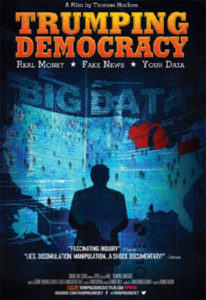“Trumping Democracy” — New Documentary Traces Trump’s Election Win
 When Donald Trump lost the popular vote by 3 million but won the Electoral College, the debate about our electoral system became more urgent.
When Donald Trump lost the popular vote by 3 million but won the Electoral College, the debate about our electoral system became more urgent.
On November 7, the New York Times editorial board published the opinion piece, “Let the People Pick the President.” It proposed the National Popular Vote interstate compact as a solution.
Now, a new documentary, “Trumping Democracy: Real $*Fake News*Your Data,” offers insights which not only a call into question the process and relevancy of the Electoral College, but points to disturbing factors brought on by the digital age.
Director Thomas Huchon, a French journalist and documentary filmmaker, has drilled down on how unvetted information — and disinformation — can rapidly go viral on the Internet. His search, post-election, to understand how Trump captured the presidency, led him to examine cutting-age digital tools, dark money, and a network of interrelated players with common ideological goals.
At the center of this configuration is hedge-fund billionaire and computer scientist Robert Mercer. (His daughter Rebekah went on to become a leader in the Trump transition team.) Breitbart News, Steve Bannon, and KellyAnne Conway are planets in the constellation, along with David Bossie, known for his role as president of Citizens United. Mercer was a staunch supporter of altering campaign election funding rules, that for sixty years had reined in individual and corporate donations.
Huchon breaks down his story into three chapters: Lies; Cover-Up; Manipulation. The first two sections review better known material. It is the final third of the film that connects the players in a way that is revelatory and alarming. Huchon taps a group of experts from the fields of journalism, political strategy, law and technology to deliver takeaways that are unsettling.
The narrative begins with a portrait of a New York Trump voter disgusted with “mainstream media.” He gets his news from online outlets, including “pseudo-news” sites that push stories like the bogus child sex trafficking ring of #Pizzagate fame.
Paul Horner, “fake news” creator and prankster, is on hand to speak about fictitious stories he has posted. Disseminated by right wing outlets, Horner references a fictitious post he wrote that was picked up by Eric Trump, who retweeted it with the hashtag #CrookedHillary.
The backstory of Breitbart News is delineated and defined as a platform promoting anti-immigrant sentiment, misogyny, and white supremacist content. A graph depicts how the Breitbart readership expanded dramatically in 2017 during the months of October and November, from 45 million unique monthly users to over 100 million.
Tad Devine, political strategist, runs down the changed habits of how the public consumes news, unlike the days when three broadcasting stations delivered the nightly report. He emphasizes Trump’s “delegitimization of the mainstream media.” Pollster Ben Tulchin notes that Conservatives don’t believe the reporting of the New York Times, the Washington Post, or CNN.
As a candidate, Trump stated he would express the facts “plainly and honestly.” Yet, the nonpartisan fact-checking website Politifact found differently. It showed that Trump’s statements had a 4 percent veracity rate and that 33 percent of his assertions were actually false.
FoxNews and Breitbart helped Trump to create and propagate his own truth. Trump painted himself as the sole person who could “drain the swamp” and make America a “winner” again.
Meanwhile, behind the scenes, the reclusive Mercer took the opportunity to put his unlimited funds into the service of his extreme vision of limited government.
This trail is fleshed out in the “cover-up” segment. No coincidence that the three entities in question share the same building address in Los Angeles. They are Breitbart News, Glittering Steel Productions, and the hedge fund Renaissance Technologies –where Mercer was co-CEO. (Note: Mercer has since stepped down.)
At RenTech, Mercer used the trading algorithm he innovated to make a fortune. That mathematics morphed into a technology for other purposes.
Mercer has become a top billionaire on the political scene. Besides his own family foundation, he funds a host of conservative think tanks. Guardian journalist Carole Cadwalladr gives advice on how to get a clear picture of Mercer’s game plan: “Follow the money.”
Tax documents clearly map the recipients of Mercer’s support. Unsurprisingly, the Heritage Foundation, the Media Research Center, the Government Accountability Institute, and the Heartland Institute are on the list. Mercer also paid for an ad against the placement of a mosque near the World Trade Center locality.
In 2011, Mercer invested $10 million in Breibart News, developing a designated media arm to promote his point of view. Steve Bannon took over the Breibart helm and publicly pronounced his goal of “deconstructing the government of the United States.”
As the 2016 election season geared up, Mercer backed Ted Cruz and put $13 million into Cruz’s “Keep the Promise” campaign. As Trump decimated his opponents, Mercer shifted his allegiance to Trump — to the tune of $15 million.
With major money invested in Trump, Mercer moved to take over the campaign reins in July of 2016. His daughter Rebekah met with Trump and offered more money –along with the “talents” of Bannon to spearhead the campaign. Conway, formerly on board the Mercer train for Cruz, and Bossie, joined the team.
Trump remaining unbeholden to outside interests was no longer remotely tenable. Key clues to the incestuous entanglements became clear when monies and paper trails became evident by looking at records filed with the Federal Election Commission (FEC). There were no payments in the Trump campaign for Bannon’s salary. However, through a Mercer PAC, there are recurring payments to Glittering Steel, the company run by Bannon. In five months, the production company received $302,000.
The Campaign Legal Center has filed a complaint maintaining that Glittering Steel is a front for Bannon, while noting that Mercer’s company and Breitbart News are in the same office building.
The third, and most powerful section, is what Huchon has been building toward. He tracks back to his original query: How did Trump win the election?
That piece of the puzzle begins with the London firm, Strategic Communications Library (SCL). Their mission is to evaluate data to determine “what impacts people and how they think.” It’s known as “Psychological operations (PSYOP).”
SCL claims they provide “behavioral influence planning and evaluation” for clients who want to “influence or treat a problem.” It references a roster of clients like NATO, the British Ministry of Defense, the NSA, and the U.S. State Department. They polish their creds with the example of how their tactics helped to advance “healthcare in Ghana.”
The flip side isn’t as magnanimous. These methods are implemented to manipulate people without their awareness; often utilized to create a problem — in order to solve it. Instigated to organize protests in Nigeria in 2007, as Cadwalladr pointed out, “It’s been used by authoritarian regimes.”
SCL started a “subsidiary” branch to manage data in 2013 called Cambridge Analytica. They set up shop in the United States and partnered with Mercer. Bannon became Vice President. Their tagline was, “The right message in front of the right person at the right time.”
Cambridge Analytica employed “data-modeling” by taking readily available personal data off the web (age, income, address, religion, gun ownership), as well as buying it from banks, credit card companies, and the social media giants Google, Facebook, and Twitter. They were able to accrue four to five thousand pieces of data for 230 million adults in America.
And it’s all legal.
Added into the mix are data points that determine consumer and lifestyle behaviors, as well as political viewpoints. The personality traits of “openness, conscientiousness, extraversion, agreeableness, and neuroticism” (OCEAN) get calculated. “Behavioral micro-targeting uncovers what “motivates” individuals — to influence their vote.
Expert Michal Kosinski explains digital data and psychological profiling. He created a test specifically for Facebook, and explained how Facebook “Likes” can create an accurate assessment of a subject’s religious views, politics, sexual orientation, personality and intelligence.
Cambridge Analytica offered their services to Trump, who was not interested until he learned they had worked on the successful Brexit initiative. The two parties connected in June 2016. By the end of July, Trump had forked over $6 million to Cambridge Analytica. Another $5 million would be forthcoming.
What did these dollars buy? A tactic based on the realization that Trump didn’t have a shot at winning the popular vote. However, if he went after wavering voters in key swing states, winning the Electoral College was attainable. The goal was to isolate conservative Democrats who might vote for Trump and geo-target them — down to their zip codes.
Looking at Michigan, Wisconsin, and Pennsylvania, Cambridge Analytica concentrated on those undecideds by defining thirty-two personality types and determining which voters were the most vulnerable to Trump’s messages of fear and anger.
Trump revisited those geographical areas before Election Day. Simultaneously, this demographic of anxious voters received personal messages on Facebook tailored explicitly to them. These “dark posts” disappeared hours after appearing in the specified user’s timeline. They remain untraceable and without any record — except on Facebook’s server.
It worked. Trump got 77,000 votes from those three swing states.
“Trumping Democracy” was first released in France in June 2017. During production, Cambridge Analytica refused all requests for interviews.
In October, the company was called upon by the House Permanent Select Committee on Intelligence (HPSCI) to share their records, detailing their relationship to the Trump campaign.
Democracy may not be dead yet.
The film is available to stream on Amazon and Vimeo beginning November 21.



